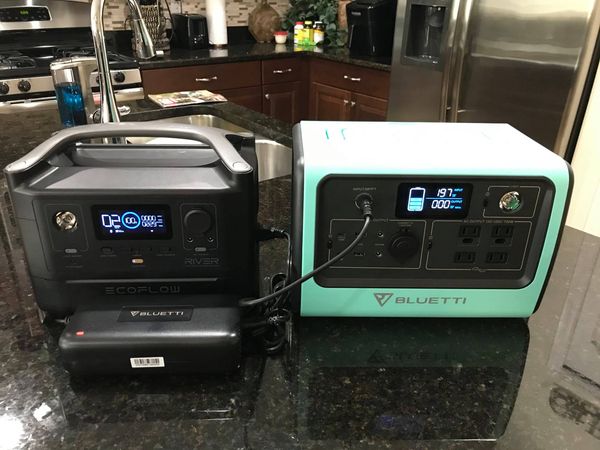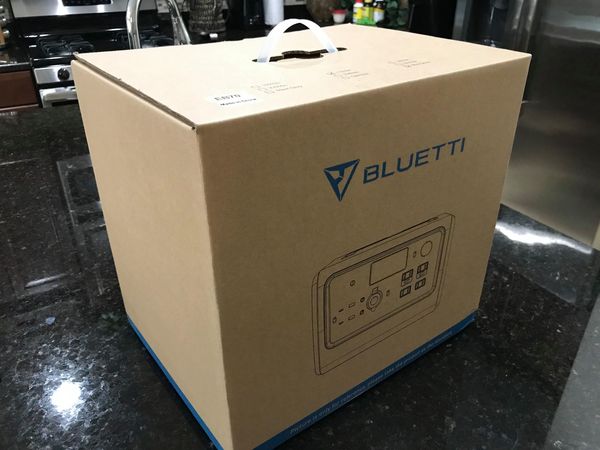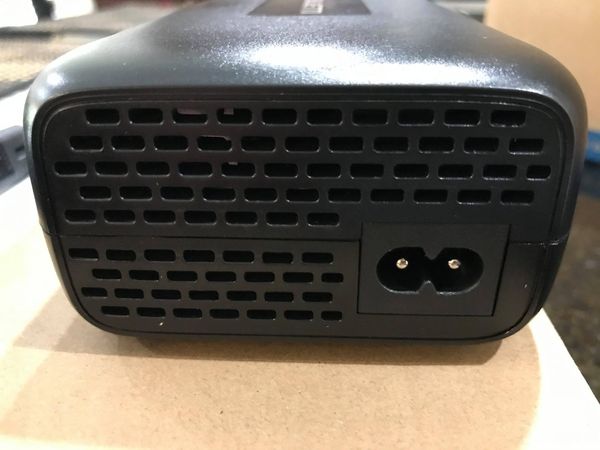GOLDILOCKS IS ALIVE AND WELL IN TODAY’S WORLD!
After owning several Sogens the past few year and patiently waiting to get my hands on the new Bluetti EB 70, I have spent the last two days putting it though its paces. For those of you that don’t like long reads, I will cut to the chase . It is a “right sized ” mid range capacity sogen that will work well for the average user. It is a basic unit with enough capacity to power most items in most circumstances with a larger than average battery life all with a low cost per watt hour. This one is just right for a variety of users.
Now for the rest that want details, details, details .
The Bluetti EB70 arrived in perfect condition and was double packaged inside a thick outer carton that contained the actual product box. The inner box was well padded, contained an accessory box with paperwork and the unit arrived approx. 60% charged.
I own several Ecoflow R600 series units and they are an obvious competitor to the EB700. Included are side by side pics of the two units and I used the R600 to perform car charging and AC power for AC charging. Overall the EB70 is about an inch wider and deeper but the same overall height when including the R600’s handle.
BELOW ARE THE BASIC SPECS AND CAPACITIES:
• 716Wh Ah - 716Wh
• Battery Cell Type: LiFePO4
• Display than automatically shuts off even when not desired
• Dimensions: 12.68.58.7 in.
• Weight: 21.4lbs
• Operating Temperature: -4°F-104°F
OUTPUT:
• 4*AC (Pure Sine Wave): 100-120V, 700W (1400W Surge) , 50Hz / 60Hz
• 1*Car Port: DC Regulated 12V,10A
• 2*DC Outputs: Regulated 13.4V, 10A, 5.5mm x 2.1mm
• 2*USB Type-C: 5V,3A / 9V,3A /12V,3A / 15V,3A / 20V,3A / 20V,5A (100W Max)
• 2*USB-A: 5V,3A
• 1*Wireless Charging Pad: 5W / 7.5W / 10W / 15W
CHARGING INPUT:
• DC Input: 12V~28V, 8A (200W Max), 7.9mm x 0.9mm female socket
INCLUDES:
• 1*BLUETTI Portable Power Station EB70 (716Wh/700W)
• 1*AC Adapter & Cable with built in constantly running fan
• 1*Car Charging Cable
• 1*Solar Charging Cable (DC7909 Male to MC4)
• 1*User Manual and warranty card
OPERATING RESULTS:
Battery Capacity
I received 648 watt hours out of an available 716 watt hours for a 90% efficiency rate while powering a 415 watt AC load. I ran a second test with a 156 watt AC load and received 668 watt hours for an 93% efficiency.
CHARGING……
Car charging worked flawlessly at 103 watt charging rate . 24 volt 190 watt car charging is also available for 24 volt systems.
12 volts=38 watts
13 volts=100 watts
14 volts=109 watts
AC Charging measured 197 incoming watts . The supplied charger is rated for 200 watts, includes a built in fan which works well to keep the charging brick cool during charging. The fan runs anytime the charging brick is plugged into AC power regardless of the temperature of the brick or whether it is connected and charging or not. The noise is noticeable and annoying but I cannot argue that the fan is effective at keeping the temperature of the brick low. The fan runs on the EB70 itself when charging above 95 watts and the fan is very quiet. There is a red light that appears while charging and the light turns green at the completion of the charge.
Solar Charging is a mixed bag. While the rated input is 200 incoming watts, the 8 amp current limit makes this very difficult to achieve. The EB70 accepts incoming voltage from 12 to 28 volts (29.75 upper limit real world cut off) and to get close to the 200 watt potential you will need a panel in the upper voltage range. Below are some charging voltages with wattages I achieved: (I know these do not calculate at exactly 8 amps but they were what I observed.
15 Volts = 121 watts
18 Volts = 142 watts
20 Volts = 158 watts
22 Volts = 172 watts
25 Volts = 193 watts
25 to 29.75 Volts all = 193 watts.
The sweet spot for solar charging would be to find a panel that outputs from 25 to 29 volts under load . If you connect a pair of panels in parallel, the combined output cannot exceed 8 amps which makes solar panel selection challenging to get close to the 200 watt potential. I used an Aiper 160 watt folding panel that I was able to get 118 watts in single configuration and a max of 174 watts when using two connected in parallel. These panels run a little higher voltage than others I have and even then, I was up against the 8 amp limit. Bottom line on solar charging is that even though you have a 200 watt potential for solar charging, you will be challenged to get close to that and be better off with the real world expectation of using a single 120 watt panel. The EB 70 would be much more solar usable with a 12 amp limit so that two panels can be connected in parallel without exceeding the incoming amperage limit.
AC INVERTER OUTPUT……
This is strength for the EB70 . The inverter is load rated output from 700 to 839 watts for two minutes and from 840 watts to 1050 watts for 2 seconds. There are four AC sockets located on the front of the units, two of which have recessed holes to accept three prong cords. I personally observed that I could run a 750 watt load for over five minutes and an 833 watt load shut down at exactly two minutes as stated it would. I measured a surge of 999 watts max during a vacuum cleaner start up and the unit will go into overload consistently at 850 watts. Bottom line, the inverter will power 700 watt loads as advertised and still have enough reserve capacity to bump above somewhat for short durations. This is a good inverter for this size of unit.
DC OUTPUTS……
12 volt DC outputs. There is one Car Plug Socket and two 5521 sockets rated at 10 amps. The 12 VDC outputs operate at 13.4 volts and are fully regulated meaning the voltage out of them remain the same when the battery is full all the way until it is almost empty. This is important when running portable refrigerators. I wondered if that was a combined 10 amps output or could each of the three output sources handle a 10 amp load. The output is a COMBINED 10 amp output. Each of the three outputs was capable of 10 amps separately but the 10 amps are shared by all three.
USB Outputs. The two USB ports worked as advertised at 3 amps each and had not problems.
Power delivery ports. The EB70 is class leading with the inclusion of two 100 watt power delivery ports. I charged two laptops and each port is capable of outputting a 100 wattage power delivery from each port for a total of 200 watts. Great job Bluetti.
Wireless charging. This old man ain’t got me none of them fancy doo dads that can charge wirelessly so I will have to take the word of others that the wireless 15 watt charging pad works as intended.
DISPLAY SCREEN:
The EB70 has a very basic display screen . Shown on left side of the screen is the battery level (state of charge) bar in 20% increments. This bar will cycle up and down during charging and turn non moving when fully charged. I personally prefer to see an exact % state of charge as I find it much more useful and accurate. The right side of the screen displays the incoming (charging) and outgoing watts. These are large numerals and easy to see indoors. There are various indicators that pop up for overload and other warning indicators. I did notice that the wattage output numbers differed by approx. 24 watts lower than my Killawatt meter was reading.
Overall if you are a basic, just use the thing type of person you will like the display. If you are like me and want to see all the details including time remaining for both charging and discharging you will come away wanting more. The one single thing that I disliked about the screen is that it times out after approx. 20 seconds and you have to press one of the three operation buttons to turn the view the display again. This single feature bugged me throughout the entire test and it would be an advantage to toggle this feature on and off. I for one would gladly give up a watt or two just to keep the display on if I wanted to. It works and functions but not much more.
OPERATION BUTTONS:
There are only three buttons to push on the entire unit. AC inverter button when pushed turns the unit on and enables AC power to be outputted. The DC output button when pushed enables power to the DC output sockets, the USB ports, the Power Delivery ports and the wireless charging. The light button turns on the front facing light with three modes. High, Low and Cool SOS flashing.
All three of the switches are identical and poorly lit which makes it hard to determine if they are off or on when outdoors. There is no main ON / OFF button to operate the EB70. Pressing the AC or DC button turns the unit on and turning both of these buttons to the off position turns the machine off. I would prefer a separate “ON” switch that was well lit and clearly identifiable as to whether the unit is on or off.
LIGHT:
Arguably the best and most crucial feature of any Sogen is the built in light. The light on the front face of the EB70 is a standard 3 watt LED light with High / Med and SOS functions. I had high hopes when the flood light came out on the AC50S which was usable in a power outage and for camping. Sadly this light was not included (or an even larger higher power version) on the rear side of the EB70. This would have been a big plus to include for use in camping, power outage and simple van dweller uses. The entire rear section of the EB70 is a blank slate and could easily have accommodated a large functional area flood light. Maybe next time………
COOLING FAN:
The cooling fan on the EB70 is powerful and very quietly moves a large amount of air . The fan will not come on until the AC inverter output exceeds 300 watts or reaches a high temp threshold. Th e fan on this unit is one of the best I have seen with keeping the unit cool and remaining quiet and unobtrusive.
The fan runtime parameters are: The internal fan of EB70 will turn on in one of the following 3 situations: (1) AC Output>300W, (2) DC Output>95W, (3) Input Power>90W
My TV used 156 watts and I like to use it for capacity tests. It is very noticeable when the fans turn on while watching TV and the EB70 does not come on or need to come on in this situation. Big advantage here for Bluetti.
LIKES:
Battery cycle capacity of 2,500 cycles before losing 20% of the capacity
Battery capacity . 717 watt hours is great in this size of machine
Inverter Strength . Very capable inverter capacity in a smaller size unit
Fan noise . Very quiet during operation capered to some competitors
(2) Power delivery ports . Class leading 100 watts each
Size. Good compact unit with good construction and appearance.
OPPORTUNITIES FOR IMPROVEMENT:
No on board charger or fast AC charging. The days of the power brick are rapidly numbered and need to go away. An on board charger that utilizes industry standard
power cords are the most convenient method of charging. The included AC brick does the job but at 200 watts charging rate and the loud fan are not competitive with another manufacturers offering that includes both on board and fast charging.
Solar charging input limitations. The 8 amp limitation on solar input makes it almost impossible to achieve the 200 watt available charge rate incorporated in the machine. If you connect panels in parallel the 8 amp limit will not allow 200 watts incoming. You cannot connect multiple panels in series because of the 29 volt incoming limit. The solution to this would be to simply raise the input voltage limit to 65 volts which would allow the 200 watt charge rate to be achieved. (400 watts incoming would be even better)
Needs option for display to remain on without going blank every 20 seconds. This was very annoying for me during testing.
App control would be nice to keep competitive. This is a disappointment to not have this feature on a newly introduced product. App control would enable user to be able to have access to many additional settings which would satisfy a wider customer base. Those that did not value or have use for app control could simply not use it. Also would allow for firmware upgrades which are almost a must have on these devices in today’s market.
No On / Off button . Would like a main power on, power off button to know easily if the EB70 was truly off. The small AC and DC buttons have poor outdoor visibility which allows for the unit to be left on by mistake.
Summary:
At the price point vs capability, the EB70 is a very desirable unit. If your needs are a basic high quality unit with excellent inverter and battery capacity to use in wide variety of situations, you won’t go wrong with the EB70. The battery cycle life is outstanding and you won’t find a lower cost long life unit on the market today with the capacity and features of the EB70. The construction is first rate and for most users, it has everything one needs. It is just like Goldilocks and the three bears…… This one is just right.
’ xlink:href=‘%23b’/%3e%3cuse fill=‘black’ filter=‘url(%23c)’ xlink:href=‘%23b’/%3e%3cpath fill=‘white’ d=‘M12.162 7.338c.176.123.338.245.338.674 0 .43-.229.604-.474.725a.73.73 0 01.089.546c-.077.344-.392.611-.672.69.121.194.159.385.015.62-.185.295-.346.407-1.058.407H7.5c-.988 0-1.5-.546-1.5-1V7.665c0-1.23 1.467-2.275 1.467-3.13L7.361 3.47c-.005-.065.008-.224.058-.27.08-.079.301-.2.635-.2.218 0 .363.041.534.123.581.277.732.978.732 1.542 0 .271-.414 1.083-.47 1.364 0 0 .867-.192 1.879-.199 1.061-.006 1.749.19 1.749.842 0 .261-.219.523-.316.666zM3.6 7h.8a.6.6 0 01.6.6v3.8a.6.6 0 01-.6.6h-.8a.6.6 0 01-.6-.6V7.6a.6.6 0 01.6-.6z’/%3e%3c/g%3e%3c/svg%3e)
33




